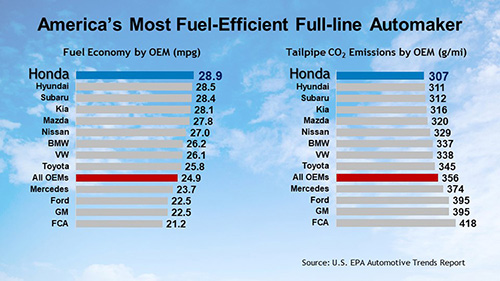President Biden recently took a positive step toward new federal vehicle emissions standards that include the Administration’s bold objective to advance America’s electric vehicle future. In so doing, the Biden Administration is aligned with the similarly bold actions taken two years ago by Honda, BMW, Ford, Volkswagen and Volvo, which entered into voluntary agreements with the state of California to establish progressive new vehicle greenhouse gas regulations.
When we entered into that agreement with California, we knew it was a bit of a risk, but for Honda, it was the right thing to do for the environment and also for our customers in all 50 states – not just those living in California and the other states that have adopted its standards. So, the Administration’s action in getting back on the pathway to strong federal fuel economy and GHG emissions standards represents an important milestone.
Honda already holds the distinction of being America’s most fuel-efficient, low-emissions full-line automaker, according to the January 2021 U.S. EPA Automotive Trends Report. That means our existing vehicle fleet has the lowest CO2 emissions of any full-line automaker. But the future direction of environmental requirements is not low CO2 emissions, it’s zero CO2 emissions.
So, in April, our global CEO Toshihiro Mibe outlined our vision to realize carbon neutrality by 2050. What made the biggest news was our vision for the complete electrification of our auto lineup in major markets around the world, including North America. We are committed to an increase in our sales of battery-electric and fuel cell electric vehicles from 40% in 2030, to 80% in 2035, to 100% by 2040.
For Honda, our commitment to carbon neutrality is a comprehensive one that will affect not only our products, but all of our corporate activities. This will require a collective effort across our entire value chain, representing huge investments over a long time horizon. In order to meet our ambitious climate goals, we will need to work closely with state and federal governments to promote policies that stimulate consumer demand for EVs, create electrification infrastructure, and support EV manufacturing jobs here in the United States. The Biden Administration has outlined plans in each of these areas, and we encourage Congressional action to enact broad, complementary, and fair policies that will achieve our goal of significant reductions in greenhouse gas emissions.
Unfortunately, there are currently efforts underway in Congress to enact unfair, discriminatory policies that will favor EVs built by a union workforce that will limit consumer choice. All American auto workers work hard to support their families, pay taxes and support their communities. Our production associates in Alabama, Georgia, Indiana, and Ohio deserve fair treatment from Congress and should not be penalized for their choice of a workplace. By providing fair and equitable treatment for all American auto workers who build EVs and by equally valuing their contributions, we can accelerate our shared environmental goal of achieving widespread EV deployment.
The transition to EVs will require that we prepare our workforce for change and we are investing in that transformation. We have many talented and highly skilled associates (employees) in the U.S. who are designing and will build our EVs in the coming years. Our confidence is driven by the fact that, over the past 40 years of building products in America, we have a history of evolving to meet the changing needs of our customers and society. We’ve gone from making small motorcycle engines to the 2-motor hybrid system in our hybrid-electric vehicles, because the strength of Honda all of these years is not the engines we make, but the Honda engineers who develop and make them. This will not change.
Finally, as we consider a zero carbon future, it’s important to emphasize that we are striving for “zero environmental impact” not only with our products, but the entire product lifecycle including our corporate activities.
In the U.S., Honda is leading auto industry efforts to decarbonize the nation’s electrical grid by adopting renewable energy to slash CO2 emissions and power our operations. Our long-term virtual power purchase agreements (VPPA) that went into effect in 2020 are now helping offset the carbon-intensive, grid-supplied electricity being used in our Ohio, Indiana, and Alabama auto plants. More than 60% of the electricity that Honda uses in North America will be covered by over one million megawatt-hours of renewable electricity from wind and solar power generated in Oklahoma and Texas.
We also are partnering with utilities and energy-sector allies to develop vehicle-to-grid (V2G) integration that is essential to our electrified future. Toward that goal, we have launched the SmartCharge beta program that enables EV customers to reduce their environmental footprint, save money while charging their electric vehicles and maximize use of renewable energy.
These are just a few of the areas where Honda is working toward a zero carbon future that will benefit our customers, our industry and the environment. The reality is that it will take continued bold action to fulfill the ambitious plans for our electrified future. This will require a coordinated society approach – individual automakers, our suppliers and technology partners, and federal, state and local governments – to increase consumer demand for electric vehicles, establish the infrastructure to support them and develop the workforce to build them. Only in this way can we stay on a successful track to achieve what is the ultimate goal of this effort, to address global climate change and the critical effort to reduce greenhouse gas emissions.
SOURCE: Honda



